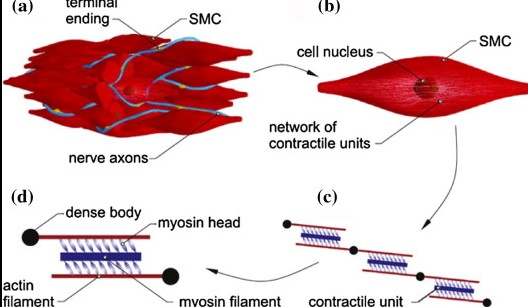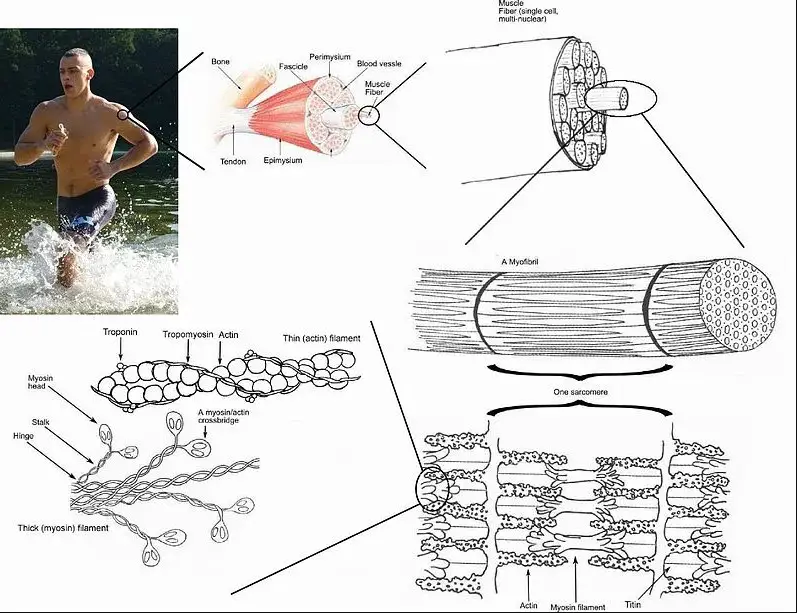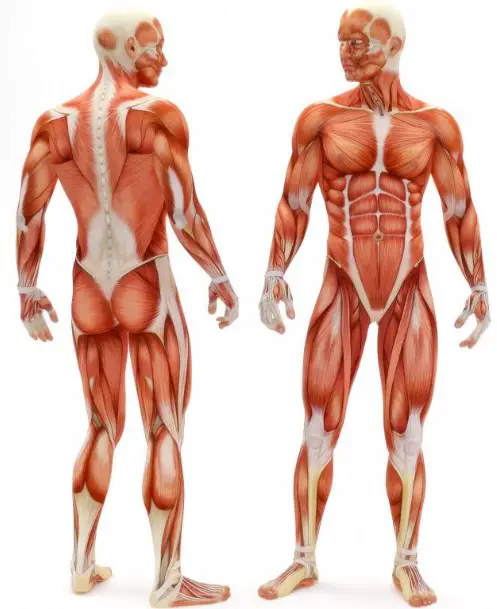Tissues in the human body can be broadly classified into two categories: contractile and noncontractile. Each plays a pivotal role in ensuring our bodies function efficiently, contributing to movements, support, protection, and various physiological processes. The distinction between these two types of tissue lies not just in their names but in their fundamental properties and functions that are crucial for the sustenance of life.
The primary difference between contractile and noncontractile tissues is their ability to generate force and movement. Contractile tissues, such as muscles, are specialized to contract and produce movement, thereby playing a direct role in the locomotion and functioning of various body parts. Noncontractile tissues, on the other hand, include types such as connective and epithelial tissues, which provide support, protection, and serve other non-movement related functions.
Contractile tissues are composed mainly of cells that have the unique ability to shorten and generate force, a property that is essential for movement and various other functions such as pumping blood through the heart. Noncontractile tissues, while not involved in producing movement, play critical roles in supporting and protecting the body, forming a framework for organs and systems, and facilitating the body’s physiological processes.

Contractile Tissue
Definition
Tissues in the human body are categorized based on their structure and function. Among them, contractile tissue stands out due to its unique ability to shorten and generate force. This ability is crucial for a wide range of bodily movements, from the beating of the heart to the movement of the limbs.
Basic Concept
The fundamental characteristic of contractile tissue is its capacity to undergo contraction. This means the tissue can actively shorten, producing movement or tension within the body. The cells in these tissues, known as muscle fibers, possess special proteins that slide past each other to cause contraction.
Role in the Body
Contractile tissues are vital for:
- Movement: Enabling locomotion and manipulation of the environment.
- Circulation: Assisting in the pumping of blood throughout the body.
- Digestion: Facilitating the movement of food through the gastrointestinal tract.
Types
Skeletal Muscle
Skeletal muscle powers voluntary movements and is attached to bones. It is characterized by its striated appearance and multinucleated cells.
Cardiac Muscle
Cardiac muscle is found in the heart. It is involuntary and features a unique interconnected structure, allowing it to pump blood efficiently.
Smooth Muscle
Smooth muscle lines organs and vessels, controlling involuntary movements such as the constriction of blood vessels and the movement of food through the digestive system.
Characteristics
Composition
Contractile tissues are composed of muscle fibers, rich in actin and myosin proteins, which are essential for contraction.
Function
The primary function is to generate force and movement, critical for bodily functions such as locomotion, circulation, and digestion.
Location
These tissues are located throughout the body, in muscles attached to bones (skeletal), the heart (cardiac), and within the walls of organs and vessels (smooth).
Role in Movement
Mechanism of Contraction
The contraction mechanism involves:
- Neural stimulation: A signal from the nervous system.
- Calcium release: Triggers the sliding mechanism of actin and myosin.
- ATP consumption: Provides energy for contraction.
Energy Use
Contractile tissues use ATP as their primary energy source, derived from carbohydrates, fats, and, under certain conditions, proteins.
Noncontractile Tissue
Definition
In contrast to contractile tissues, noncontractile tissues do not produce movement. Instead, they provide support, protection, insulation, and nutrient storage.
Basic Concept
The key function of noncontractile tissues is to maintain the body’s structure and protect internal organs. They play no direct role in movement but are essential for the body’s overall integrity and function.
Function in the Body
Noncontractile tissues:
- Support the body’s structure.
- Protect organs and tissues.
- Insulate and store energy.
- Facilitate transport of substances.
Types
Connective Tissue
Bone
Provides structural support and protection for internal organs, stores minerals, and houses bone marrow.
Tendon
Connects muscles to bones, transmitting forces to enable movement.
Ligament
Connects bones to bones, stabilizing joints and supporting movement.
Neural Tissue
Transmits electrical signals across the body, facilitating communication between different body parts.
Epithelial Tissue
Lines the external and internal surfaces of the body, providing protection and facilitating absorption and secretion.
Characteristics
Composition
Noncontractile tissues are composed of a variety of cells and extracellular matrices, tailored to their specific functions and locations.
Function
They do not contribute to movement but play crucial roles in supporting, protecting, and maintaining the body.
Location
Found throughout the body, in bones, tendons, ligaments, nervous system, and as linings of cavities and organs.
Role in Support and Protection
Structural Support
Noncontractile tissues provide a framework for the body, supporting tissues and organs.
Protection Mechanisms
They protect the body from physical damage and invasion by pathogens, and participate in the body’s immune response.

Key Differences
Structural Differences
Cellular Composition
The cellular composition of contractile and noncontractile tissues is fundamentally different. Contractile tissues, such as muscles, are primarily made up of muscle fibers that contain actin and myosin proteins essential for contraction. These fibers are densely packed, allowing for efficient force generation and movement. In contrast, noncontractile tissues consist of a wider variety of cell types, including fibroblasts in connective tissues, osteocytes in bones, and neurons in neural tissues, each serving specific structural and functional roles without the ability to contract.
Physical Properties
Physical properties such as elasticity, flexibility, and rigidity differ significantly between these tissue types. Contractile tissues exhibit high elasticity and flexibility, enabling them to stretch and return to their original shape, which is vital for movement. Noncontractile tissues vary widely in their physical properties; bones are rigid, providing structure and support, whereas tendons and ligaments are more flexible, yet strong, to connect and stabilize bones and muscles.
Functional Differences
Role in Body Mechanics
The role in body mechanics highlights a clear functional divergence. Contractile tissues are the engine of the body, driving movements through muscle contraction, from voluntary motions like walking to involuntary ones like the heartbeat. Noncontractile tissues, however, provide the chassis; they support, protect, and structure the body, ensuring the engine’s efforts result in coordinated, efficient movement.
Response to Stimuli
Another key difference is how these tissues respond to stimuli. Contractile tissues respond to neural stimuli by contracting, an action that is swift and precise, enabling immediate physical responses. Noncontractile tissues have a more indirect response, primarily involved in the slower, supportive reactions such as inflammation, healing, and growth, which are crucial for maintaining homeostasis and protecting the body from harm.
Clinical Relevance
Injury and Repair
The process of injury and repair significantly differs between contractile and noncontractile tissues. Contractile tissues like muscles can suffer from tears, strains, and fatigue damage, which are typically repaired through cellular regeneration and fibrosis, sometimes requiring intervention to restore function. Noncontractile tissue injuries, such as bone fractures or ligament tears, follow a different repair pathway, often involving immobilization, and in some cases, surgical intervention to ensure proper alignment and healing.
Therapeutic Approaches
Therapeutic approaches for these tissues also vary. Physical therapy and rehabilitative exercises are commonly prescribed for injuries to contractile tissues, aiming to restore strength, flexibility, and function. For noncontractile tissues, treatment may include surgery, casting, and bracing, alongside rehabilitation to ensure correct healing and to prevent future injuries.
Interaction in the Human Body
Cooperation Between Tissues
The cooperation between contractile and noncontractile tissues is essential for bodily functions. For instance, skeletal muscles (contractile) attach to bones (noncontractile) via tendons (noncontractile) to facilitate movement. This synergy allows for the smooth execution of complex movements, from running to the fine motor skills required for writing.
Impact on Health and Disease
The impact on health and disease underscores the importance of understanding these tissue types. Disorders affecting contractile tissues, such as muscular dystrophy, impact movement and physical capabilities, while diseases affecting noncontractile tissues, like osteoporosis, compromise structural integrity and protection. Recognizing the signs and symptoms related to each tissue type can lead to early diagnosis and more effective treatments.
Frequently Asked Questions
What is contractile tissue?
Contractile tissue refers to the type of tissue in the body that is capable of contraction. This includes skeletal muscles, cardiac muscles, and smooth muscles. These tissues are characterized by their ability to shorten and generate force, facilitating movement and various functions like breathing and circulating blood.
How do noncontractile tissues support the body?
Noncontractile tissues, such as connective tissues (including bone, tendon, and ligament), neural tissue, and epithelial tissue, provide support and protection for the body. They help in maintaining the body’s structure, protecting internal organs, and facilitating the passage of substances across their membranes, playing an essential role in the body’s overall function and stability.
Can noncontractile tissues become damaged?
Yes, noncontractile tissues can become damaged due to various factors including physical injury, diseases, and aging. Such damage can affect the body’s ability to provide structural support, protect organs, and perform other critical functions. Recovery and repair processes vary depending on the type of tissue and the extent of the damage.
Why is understanding the difference between these tissues important?
Understanding the difference between contractile and noncontractile tissues is crucial for comprehending how the body functions, diagnosing medical conditions, and developing effective treatments. This knowledge helps in appreciating the complexity of bodily movements and the myriad ways the body protects, supports, and maintains itself.
Conclusion
Recognizing the distinctions between contractile and noncontractile tissues is fundamental to understanding human anatomy and physiology. These tissues, though vastly different in function and structure, work in harmony to facilitate movement, provide support, protect the body, and carry out numerous essential physiological processes. Their interplay is critical for maintaining health and responding to challenges.
The importance of both contractile and noncontractile tissues in the body’s overall function underscores the complexity and marvel of the human body. As we continue to explore and understand these fundamental differences, we pave the way for advancements in medical science, enhancing our ability to treat disorders and improve the quality of life.

